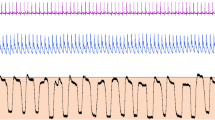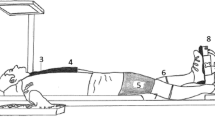Summary
Experiments were performed to determine to what extent increments in esophageal and abdominal pressure would have on arterial blood pressure during fatiguing isometric exercise. Arterial blood pressure was measured during handgrip and leg isometric exercise performed with both a free and occluded circulation to active muscles. Handgrip contractions were exerted at 33 and 70% MVC (maximum voluntary contraction) by 4 volunteers in a sitting position and calf muscle contractions at 50 and 70% MVC with the subjects in a kneeling position. Esophageal pressure measured at the peak of inspirations did not change during either handgrip or leg contractions but peak expiratory pressures increased progressively during both handgrip and leg contractions as fatigue occurred. These increments were independent of the tensions of the isometric contractions exerted. Intra-abdominal pressures measured at the peak of either inspiration or expiration did not change during inspiration with handgrip contractions but increased during expiration. During leg exercise, intraabdominal pressures increased during both inspiration and expiration, reaching peak levels at fatigue. The arterial blood pressure also reached peak levels at fatigue, independent of circulatory occlusion and tension exerted, averaging 18.5–20 kPa (140–150 mm Hg) for both handgrip and leg contrations. While blood pressure returned to resting levels following exercise with a free circulation, it declined by only 2.7–3.8 kPa after leg and handgrip exercise, respectively, during circulatory occlusion. These results indicate that straining maneuvers contribute 3.5 to 7.8 kPa to the change in blood pressure depending on body position.
Similar content being viewed by others
References
Alam M, Smirk FM (1938) Observations in man on a pulse accelerating reflex from the voluntary muscles of the legs. J Physiol 92:167–177
Clarke RSE, Hellon RF, Lind AR (1958) The duration of sustained contractions of the human forearm at different muscle temperatures. J Physiol 143:454–473
Finley JP, Bonet JF, Waxman MB (1979) Autonomic pathways responsible for bradycardia on facial immersion. J Appl Physiol 47:1218–1222
Freyschuss U (1970) Cardiovascular adjustment to somatomotor activation. Acta Physiol Scand [Suppl] 342:1–63
Funderburk CF, Hipskind SG, Welton RC, Lind AR (1974) Development of and recovery from fatigue induced by static effort at various tensions. J Appl Physiol 37:392–396
Goodwin GM, McCloskey PI, Mitchell JH (1972) Cardiovascular and respiratory responses to changes in central command during isometric exercise at constant muscle tension. J Physiol 226:173–190
Heistand DD, Abboud FM, Eckstein JW (1968) Vasoconstrictor response to simulated diving in man. J Appl Physiol 25:542–549
Humphreys PW, Lind AR (1963) The blood flow through active and inactive muscles of the forearm during sustained hand-grip contractions. J Physiol 166:120–135
Krogh A, Lindhard J (1913) The regulation of respiration and circulation during the initial stages of muscular work. J Physiol 47:112–136
Lind AR (1984) Cardiovascular responses to isometric contractions (static effort). In: Handbook of Physiology Am Physiol Soc Washington DC, vol. III chap 26, pp 947–966
Lind AR, Williams CA (1979) The control of blood flow through human forearm muscles following brief contractions. J Physiol 288:529–547
Lind AR, Taylor SR, Humphreys PW, Kennelly BM, Donald KW (1964) The circulatory effects of sustained voluntary muscle contraction. Clin Sci 27:229–244
Palmero HA, Caeiro TF, Iosa DJ, Bas J (1981) Baroreceptor reflex sensitivity index derived from phase 4 of the Valsalva maneuver. Hypertension [Suppl II] 3:134–137
Samnegard H, Tyden G, Thulin L (1980) Internal carotid artery blood flow during the Valsalva manoeuvre in man. Acta Chir Scand [Suppl] 500:57–59
Sanchez J, Sebert Ph (1983) Sex differences in cardiac responses to breath holding during dynamic and isometric exercises. Eur J Appl Physiol 50:429–444
Sarnoff SJ, Hardenbergh E, Whittenberger JL (1948) Mechanism of the arterial pressure response to the Valsalva test: the basis for its use as an indicator of the intactness of the sympathetic outflow. Am J Physiol 154:316–327
Sharpey-Shafer EP (1965) Effect of respiratory acts on the circulation. In: Handbook of Physiology: Circulation, vol 3 Am Physiol Soc Washington DC, pp 1875–1886
Shepherd JT, Blomqvist CG, Lind AR, Mitchell JH, Saltin B (1981) Static (isometric) exercise, retrospection and prospection. Circ Res [Suppl I] 48:179–188
Staunton HP, Taylor SH, Donald KW (1964) The effect of vascular occlusion on the pressor response to static muscular work. Clin Sci 27:283–291
Wiley RL, Lind AR (1971) Respiratory responses to sustained static muscular contractions in humans. Clin Sci 40:221–234
Williams CA, Mudd JG, Lind AR (1981) The forearm blood flow during intermittent handgrip isometric exercise. Circ Res 48 [Suppl I] 110–117
Williams CA, Douglas JE, Miller G, Karl A, Wiley RL, Lind AR (1987) The relationship between changes in arterial pressure, esophageal pressure and the emg of various muscle groups during the L-1 straining maneuver at different spine-to-thigh angles. Dept Air Force Technical Report No. (in press)
Author information
Authors and Affiliations
Rights and permissions
About this article
Cite this article
Williams, C.A., Lind, A.R. The influence of straining maneuvers on the pressor response during isometric exercise. Europ. J. Appl. Physiol. 56, 230–237 (1987). https://doi.org/10.1007/BF00640650
Accepted:
Issue Date:
DOI: https://doi.org/10.1007/BF00640650




